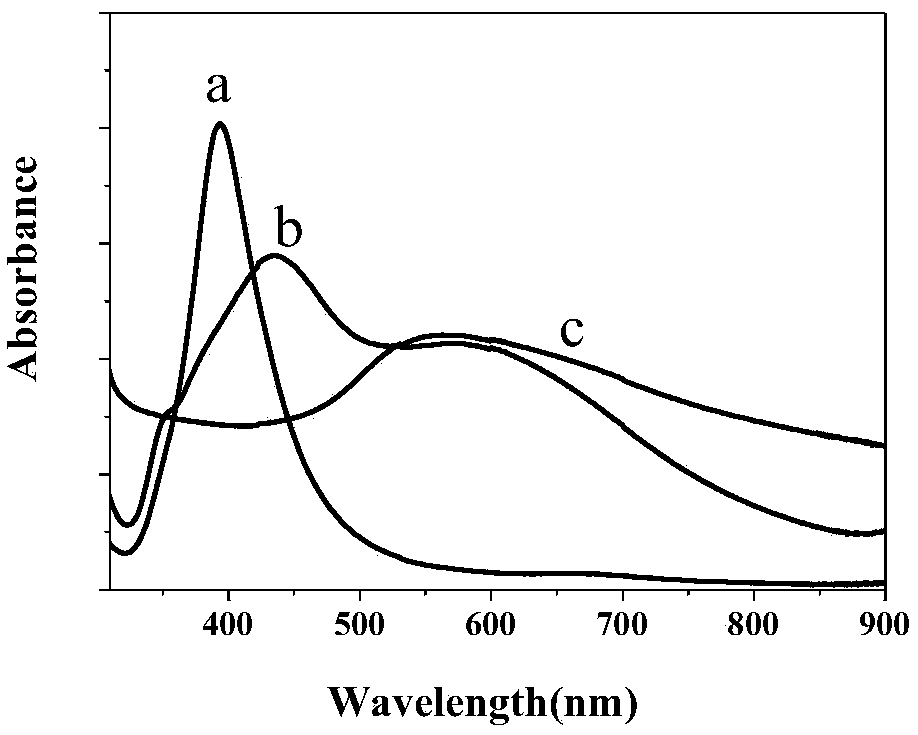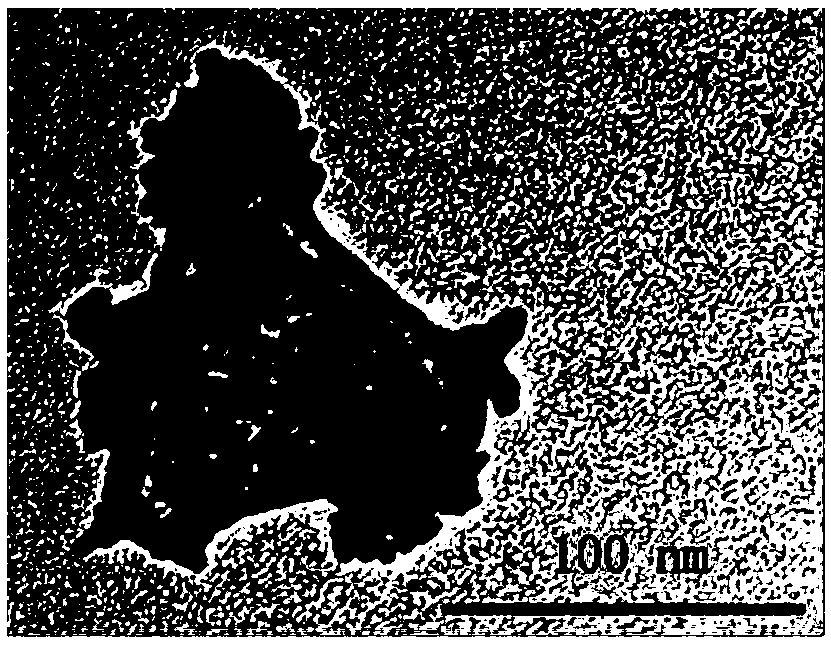Electrochemical sensor constructed based on nitrogen-sulfur co-doped graphene-loaded triangular core-shell nanocomposite, and application thereof for detecting quercetin
A technology of core-shell nanomaterials and nanocomposites, applied in the direction of material electrochemical variables, scientific instruments, analytical materials, etc., can solve the problems of not being widely used, poor stability, easy agglomeration, etc., to improve stability and catalytic performance, The effect of increasing the contact interface and sufficient activity
- Summary
- Abstract
- Description
- Claims
- Application Information
AI Technical Summary
Problems solved by technology
Method used
Image
Examples
Embodiment 1
[0047] The preparation of embodiment 1 nitrogen-sulfur co-doped graphene
[0048] Take 10mL graphene oxide (0.5mg / mL), weigh L-cysteine according to the mass ratio of graphene oxide and L-cysteine as 1:5, mix the two with ultrasound for half an hour, and disperse evenly Put it into an autoclave and heat up to 180°C, and react for 8 hours. After cooling to room temperature, pour the solution into a centrifuge tube, centrifuge at 30,000r / min for 5 minutes, remove the supernatant, dilute with water and continue centrifuging until the excess L-cysteine is eluted. Save the cleaned nitrogen-sulfur co-doped graphene for future use.
Embodiment 2
[0049] The synthesis of embodiment 2 silver triangular nanoparticles
[0050] 1. Synthesis of silver nanoseed crystals
[0051] At constant temperature (25°C), take 20mL, 0.25mmol / L AgNO 3Mix solution with 0.25mmol / L trisodium citrate, stir vigorously; then add 0.60mL freshly prepared and iced 10mmol / L sodium borohydride solution to the mixture at one time, stir rapidly for 30s, the solution turns yellowish brown , to obtain Ag seeds, and the reaction system was kept away from light for further use. The control seed aging time is 12h.
[0052] 2. Preparation of silver triangular nanoparticles
[0053] Add 0.50 mL, 0.1mol / L ascorbic acid (Vc) solution to 10mL, 80mmol / L cetyltrimethylammonium bromide (CTAB) solution, shake the mixture; then add 0.25mL, 10mmol / L L AgNO 3 solution, mix evenly; then add 0.20mL aged seed solution, shake the mixed solution; finally, add 0.10mL, 1mol / L NaOH solution to the above system, mix well, and let stand for about 10min. Store the reacti...
Embodiment 3
[0055] Example 3 Preparation of Ag@Au triangular core-shell nanomaterials
[0056] Take 2000 μL of the above-prepared silver triangle nanoparticles and put them into a beaker with 3000 μL of ultrapure water, add 13uL, 117.6mmol / L HAuCl 4 Solution, stirred and mixed evenly, cooled in an ice bath for about 10 minutes, slowly added dropwise 1000 μL, 0.1mol / L ascorbic acid, stirred vigorously during the dropping process, and kept in an ice bath for 40 minutes to obtain the Ag@Au triangle Core-shell nanomaterials.
[0057] figure 2 It is the ultraviolet spectrogram of silver nanoparticles, silver triangles and Ag@Au nanoparticles. Silver nanoparticles (curve a) have an obvious characteristic absorption peak at around 400nm, indicating that silver seeds have been successfully synthesized; and Ag triangular nanoparticles (Curve b) has two characteristic absorption peaks at 445nm and 570nm respectively; as Au is coated on the surface of Ag triangular nanoparticles, the characteri...
PUM
| Property | Measurement | Unit |
|---|---|---|
| recovery rate | aaaaa | aaaaa |
Abstract
Description
Claims
Application Information
 Login to View More
Login to View More - R&D
- Intellectual Property
- Life Sciences
- Materials
- Tech Scout
- Unparalleled Data Quality
- Higher Quality Content
- 60% Fewer Hallucinations
Browse by: Latest US Patents, China's latest patents, Technical Efficacy Thesaurus, Application Domain, Technology Topic, Popular Technical Reports.
© 2025 PatSnap. All rights reserved.Legal|Privacy policy|Modern Slavery Act Transparency Statement|Sitemap|About US| Contact US: help@patsnap.com



